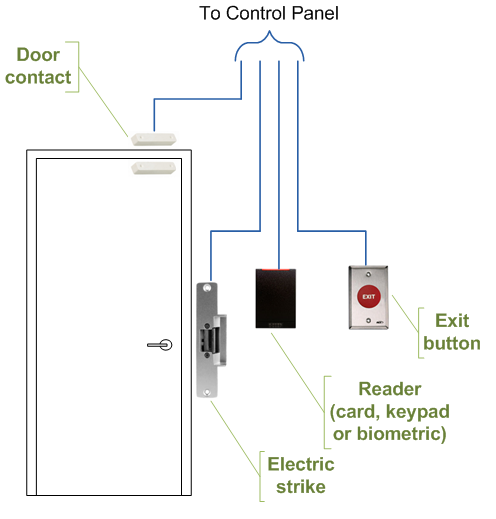| OCCUPANCY TYPE (new building) | CODE REF. | ACCESS-CONTROLLED EGRESS DOOR REQUIREMENTS |
| AMBULATORY | ||
| ASSEMBLY | (12.2.2.2.5, and 7.2.1.6.2) | Allows access-controlled egress doors in compliance with 7.2.1.6.2. (Except when the building is occupied, the locking system shall be disabled.) |
| BUSINESS | (38.2.2.2.5, and 7.2.1.6.2) | Allows access-controlled egress doors in compliance with 7.2.1.6.2. |
| EDUCATIONAL | (14.2.2.2.3, and 7.2.1.6) | Allows special locking arrangements in accordance with 7.2.1.6. |
| HEALTHCARE | (18.2.2.2.4(3), and 7.2.1.6.2) | Allows access-controlled egress doors in compliance with 7.2.1.6.2. |
| ONE & TWO FAMILY DWELLINGS | (24.2.2.2.2, and 7.2.1.6.1) | |
| HOTELS AND DORMITORIES | (28.2.2.2.3, and 7.2.1.6.2) | Allows access-controlled egress doors in compliance with 7.2.1.6.2. |
| APARTMENTS | (30.2.2.2.3, and 7.2.1.6.2) | Allows access-controlled egress doors in compliance with 7.2.1.6.2. |
| MERCANTILE | (36.2.2.2.5, and 7.2.1.6.2) | Allows access-controlled egress doors in compliance with 7.2.1.6.2 in buildings protected throughout by a supervised fire detection system or an approved sprinkler system. |
| INDUSTRIAL | (40.2.2.2.3, and 7.2.1.6.2) | Allows access-controlled egress doors in compliance with 7.2.1.6.2. |
| STORAGE | (42.2.2.2.3, and 7.2.1.6.2) | Allows access-controlled egress doors in compliance with 7.2.1.6.2. |
Access Controlled Doors are electronically controlled by an access controller combined with some form of reader to identify people by their 'credentials'. This may be a keypad, a card reader, or a biometric reader. Together, the access controller and the reader provide the ability to identify an individual and authorize or deny entry to them.
- A-C-Doors shall unlock by an approved sensor that detects an approaching occupant on the egress side of the door.
- A-C-Doors shall unlock on loss of power to the sensor and/or on loss of power to the access control system that locks the door.
- A-C-Doors shall unlock by a manual release button on the wall adjacent to the door. The button should be readily accessible and clearly identified with signage that reads: PUSH TO EXIT.
- A-C-Doors unlock on activation of the building fire protective signaling system, any smoke/fire detection system, and/or sprinkler system. Doors should remain unlocked until the protective system is reset.
- Access-Controlled Egress Doors are allowed only as stated in the occupancy chapters in the table below:
Source: Securitron.com
Notes:
- Code Reference used is NFPA-101 2012 edition unless otherwise noted.
- This information is not complete and is intended to be used as quick references only. Always refer to NFPA or your local codes for complete information.
